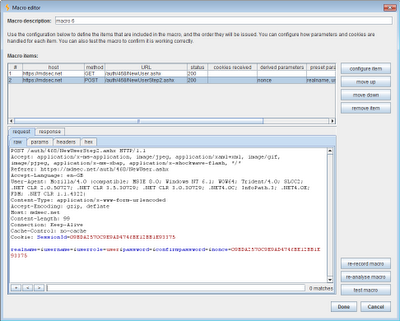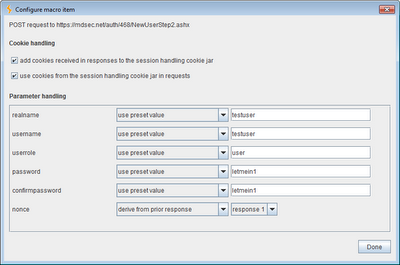 Dastardly, from Burp Suite
Free, lightweight web application security scanning for CI/CD.
View all product editions
Dastardly, from Burp Suite
Free, lightweight web application security scanning for CI/CD.
View all product editions
 Dastardly, from Burp Suite
Free, lightweight web application security scanning for CI/CD.
View all product editions
Dastardly, from Burp Suite
Free, lightweight web application security scanning for CI/CD.
View all product editions
A key part of Burp's new session handling functionality is the ability to run macros, as defined in session handling rules. A macro is a predefined sequence of one or more requests. Typical use cases for macros include:
Macros are recorded using your browser. When defining a macro, Burp displays a view of the Proxy history, from which you can select the requests to be used for the macro. You can select from previously made requests, or record the macro afresh and select the new items from the history.
When you have recorded the macro, the macro editor shows the details of the items in the macro, which you can review and configure as required:

As well as the basic sequence of requests, each macro includes some important configuration about how items in the sequence should be handled, and any interdependencies between items:

For each item in the macro, the following settings can be configured:
The ability to derive a parameter's value from a previous response in the macro is particularly useful in some multi-stage processes, and in situations where applications make aggressive use of anti-CSRF tokens. When a new macro is defined, Burp tries to automatically find any relationships of this kind, by identifying parameters whose values can be determined from the preceding response (form field values, redirection targets, query strings in links, etc.). You can easily review and edit the default macro configuration applied by Burp before the macro is used. Further, the configured macro can be tested in isolation, and the full request/response sequence reviewed, to check that it is functioning in the way you require.
Of course, the full power of using macros is only realised once they are incorporated into suitable session handling rules, to control the way that different requests are processed by Burp's tools, and work with the session handling mechanism and related functionality being used by the target application. As is perhaps already apparent, the configuration required in many real-world situations is complex, and mistakes are easily made. There is a need for a full in-tool debugger for troubleshooting the session handling configuration. In the meantime, an effective workaround is to chain a second instance of Burp as an upstream proxy from the instance being configured. The proxy history in the upstream instance will show you the full sequence of requests and responses that occur when your session handling rules are executed, helping you to find and fix any problems in your configuration.